 |
April 2016
|
April 2016 // Volume 54 // Number 2 // Feature // v54-2a5
Extension Master Gardener Social Media Needs: A National Study
Abstract
An online survey was conducted to assess the feasibility of providing training on the use of social media for the Extension Master Gardener (EMG) program. Volunteers (n = 1,275) and coordinators (n = 111) responded. Findings indicate the existence of sufficient interest in a nationally coordinated social media training. Inclusion of social media as a qualifying activity in EMG programs should be explored. Findings support inclusion of volunteers in future surveys and the possible need for increased involvement of volunteers in setting program direction. Training is being developed on the basis of the data. Future surveying of the EMG population by using random sampling to more accurately define the audience is strongly encouraged.
Introduction
The Extension Master Gardener (EMG) program is a global program that trains over 16,000 EMG volunteers in the United States annually and includes an estimated 94,865 volunteers (Cooperative State Research, Education, and Extension Service [CSREES], 2009). EMG volunteers provide in excess of 5 million hr of community participation in approved volunteer activities as payback for the education they receive(CSREES, 2009). The program has effective urban reach, with a high percentage of volunteer hours occurring in metropolitan areas (CSREES, 2009). There has not been a lot of emphasis in the program related to online audiences and the use of social media as a qualifying activity for EMG volunteers. A previous national survey of EMG coordinators made limited reference to program use of technology (McAleer, 2005). EMG volunteers have not been included in previous national surveys, which have targeted coordinators or state programs (CSREES, 2009; McAleer, 2005).
Internet use and connection speeds in the United States have greatly increased (Pew Research Center, 2014a; Pew Research Center, 2014b). Nearly all adults aged 18 to 29 (96%) use the Internet (Perrin & Duggan, 2015). VanDerZanden and Rost (2003) found that 93% of volunteers in Oregon had access to the Internet. Using online programming has been proved effective for addressing technical subject matter and extending program reach beyond boundaries at all levels (Gharis, Bardon, Evans, Hubbard, & Taylor, 2014; Langellotto-Rhodaback, 2010; Meyer et al., 2012). Providing web-related social media qualifying activities increases flexibility for volunteers unable to fulfill volunteer requirements during normal business hours (Langellotto-Rhodaback, 2010; Young, 2007).
A challenge for the EMG program is providing advanced training to expand knowledge for more experienced volunteers (McAleer, 2005; Schrock, Meyer, Ascher, & Snyder, 2000). Training volunteers to use emerging technology provides opportunities for them professionally and personally to gain knowledge while extending the program reach (Newbury, Humphreys, & Fuess, 2014). Traditionally, EMG coordinators have viewed expanding the use of information technology in the program as their responsibility (McAleer, 2005).
Purpose and Objectives
The purpose of the study described in this article was to determine interest among EMG volunteers and coordinators in a nationally coordinated online social media training and to provide direction for development of a training, if interest existed. Specific objectives of the study were
- to describe the demographic profile of EMG volunteers and coordinators;
- to determine interest among EMG volunteers and coordinators relative to social media use and training and limitations, if any, for participating in an online social media training;
- to determine preferred delivery methods for social media training;
- to determine comfort level of EMG volunteers and coordinators in guiding conversations in an online environment; and
- to explore programmatic support for including social media activities in the EMG program.
Methodology
In spring 2013 the Extension Master Gardener Community of Practice expressed interest in assessing the need for social media training for the EMG program. We developed an online survey, using Qualtrics© to collect data regarding feasibility, need and support for development, content, delivery methods, and potential barriers related to online social media training. The survey link was advertised through the eXtension listserv for EMG coordinators in June, and a reminder was sent in July. Coordinators were encouraged to include the link in all forms of correspondence with volunteers throughout their states. Also, a presentation was made at the 2013 American Society for Horticultural Science annual meeting to increase awareness. The survey was available with data collected from June to November, 2013. As incentive, respondents were entered in a drawing for a free horticulture book. The survey was branched to accommodate appropriate questions for each group.
Objective 1: Demographic Profile of Respondents
Respondents were 1,275 volunteers and 111 coordinators from 22 states (Table 1). The study appears to be one of the first attempts to collect survey data from volunteers on a national level. The survey resulted in twice as many responses from coordinators as earlier national surveys (CSREES, 2009; McAleer, 2005) because the survey distribution method encouraged response by coordinators at multiple levels rather than solely by the state coordinator.
| State |
Volunteers (n = 1,275) |
Coordinators (n = 111) |
| Alabama | 1% | |
| Arizona | 5% | 2% |
| California | 1% | |
| Connecticut | 1% | |
| Florida | 27% | 16% |
| Georgia | 2% | |
| Hawaii | 1% | |
| Idaho | <1% | 1% |
| Illinois | 11% | |
| Indiana | <1% | 7% |
| Iowa | 1% | |
| Kansas | 7% | 11% |
| Louisiana | 1% | 1% |
| Minnesota | 15% | 13% |
| Mississippi | 4% | |
| Missouri | <1% | |
| Nebraska | 5% | 5% |
| Nevada | 2% | |
| North Carolina | 8% | 6% |
| Oregon | 1% | 3% |
| Pennsylvania | <1% | 1% |
| Texas | 8% | 6% |
| Vermont | 1% | |
| Virginia | 5% | 7% |
| Washington | 3% | 5% |
| West Virginia | 2% | |
| Wyoming | 1% | 1% |
| Outside U.S. | 1% |
A majority of the coordinators were employed full-time, whereas most volunteers were retired (Table 2). In general, coordinator respondents were more highly educated, but there was greater diversity in level of education achieved among volunteers. The largest age group for volunteers and coordinators was 55 to 64 years (42% and 32%, respectively). However, an additional 62% of the coordinator respondents were fairly evenly distributed between 26 and 54 years of age, an age group accounting for only 18% of volunteers. A large number of volunteer respondents (41%) were over the age of 65, as compared to only 4% of coordinators. When asked about communication activities, including those involving technology that count toward volunteer qualifying hours, one volunteer stated, "Most of our members are older and struggle with technology." However, the majority of volunteer respondents in the study were aged 55 and older and were supportive of learning new technologies at all ages.
| Parameter | Volunteers (%) | Coordinators (%) |
| Age (years) | ||
| 18–25 | 0 | 2 |
| 26–34 | 1 | 17 |
| 35–44 | 4 | 20 |
| 45–54 | 13 | 25 |
| 55–64 | 42 | 32 |
| 65–74 | 36 | 4 |
| >75 | 5 | 0 |
| Gender | ||
| Female | 81 | 70 |
| Male | 19 | 30 |
| Employment status | ||
| Full-time | 19 | 82 |
| Part-time | 16 | 13 |
| Retired | 56 | 5 |
| Nonemployed | 9 | 0 |
| Highest level of education | ||
| High school or equivalent | 5 | 0 |
| Vocational/technical school (2-year) | 3 | 3 |
| Some college | 21 | 4 |
| College graduate (4-year) | 34 | 29 |
| Master's degree (MS or MA) | 28 | 60 |
| Doctoral degree (PhD) | 3 | 3 | Professional degree (MD, JD, etc.) | 5 | 2 |
| Other | 1 | 0 |
Objective 2: Interest in Online Social Media Training
The respondents demonstrated interest in and a willingness to participate in an online, nationally coordinated training on using social media (Table 3).
| Response |
Volunteers (%) (n = 1,143) |
Coordinators (%) (n = 107) |
| Use social media | 74 | 90 |
| Interested in online social media training | ||
| Yes | 90 | 64 |
| Maybe | 30 | |
| Willingness to use social media in your EMG program | ||
| Yes | 52 | 79 |
| Maybe | 39 | 20 |
| Willingness to participate in nationally coordinated social media training program | ||
| Yes | 60 | 64 |
| Maybe | 40 | 30 |
The primary limitation to participation in online training for both the volunteer respondents and the coordinator respondents was time (Figure 1). Over a quarter of the respondents indicated that there were no limitations. Some concern was expressed around technical skills and understanding of the Internet. Additional concerns related to social media or Internet access and program roles. A small percentage indicated that they simply lacked interest.
Figure 1.
Limitations to Participation in Online Social Media (SM) Training for EMG Programs
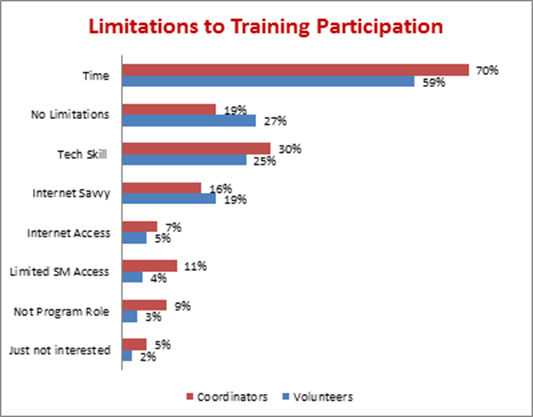
Objective 3: Preferred Delivery Methods for Receiving Online Social Media Training
EMG volunteers were asked to check all methods by which they would prefer to receive training, using gardening examples, on using social media; coordinators were asked to respond on behalf of volunteers (Figure 2). Options included short presentations, examples that show how social media might work, opportunities to brainstorm possible applications, team projects to practice what they learn in a controlled environment, learning assessments (exams), case studies, and group discussion and interaction. Preferences were evident for short presentations, social media examples, and interaction. Volunteers had moderate interest in team projects or simulations and case studies. Brainstorming possible uses was slightly favored by coordinators. Volunteer respondents were more open to testing or assessments as part of their training than coordinator respondents expected them to be.
Figure 2.
Delivery Method Preferences for Social Media (SM) Training
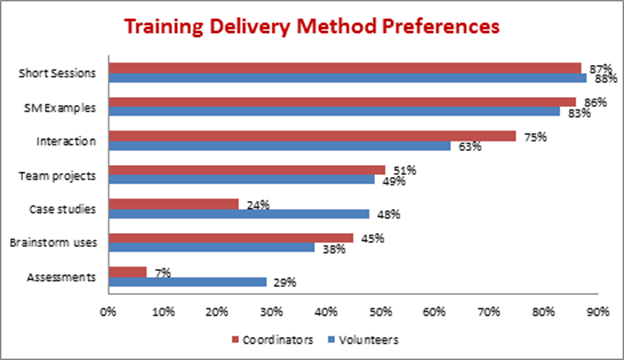
Objective 4: Comfort Level of EMG Volunteers and Coordinators
In general, the EMG volunteers responding to the survey expressed interest in exploring the incorporation of social media activities as opposed to more traditional delivery methods (face-to-face, print, phone) into the EMG program (Figure 3). Volunteers were less comfortable using online platforms than other means of communication and least comfortable guiding online discussions. Coordinators' comfort in training and advising in these areas followed a similar pattern. These findings support development of the national training to increase volunteer comfort in performing these duties and to overcome barriers of time and background that might prohibit coordinators from providing the training at the local level. The coordinators' willingness to participate in training as well helps provide implementation of new knowledge at the local level and improves their knowledge and comfort level in having volunteers pursue these activities.
Activities specifying face-to-face interaction included answering questions in face-to-face environments and guiding gardening discussions in face-to-face environments. Activities related to online environments included answering questions by email, answering questions on the Internet, writing articles for the web, and guiding gardening discussions in social media (Twitter, Facebook, etc.). Activities for which a mode was not identified were answering gardening questions, providing gardening advice, providing gardening training to general audiences, and providing gardening training to other master gardeners. In addition, answering questions by phone and writing articles for print were included.
Figure 3.
EMG Volunteers' Confidence in Performing and Coordinators' Confidence in Training and Advising Volunteers Related to Specific Activities
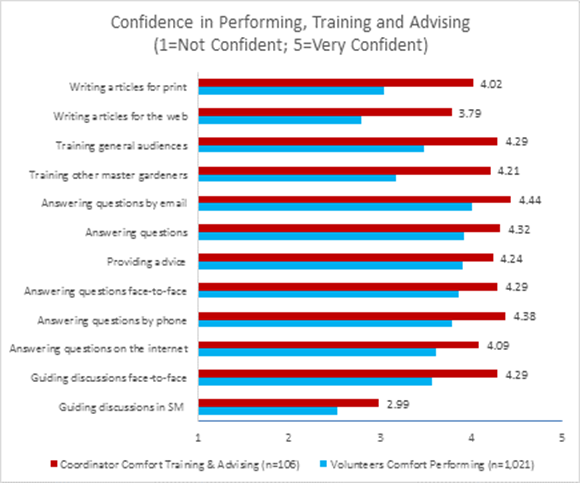
The volunteer respondents favored on-demand resources and independent learning for learning about social media for use in horticulture programming as part of a national training offered online (Figure 4). Some interest was expressed in having some interaction with instructors. Scheduled webinars, structured activities, interaction with other students, and guided public interaction were not as highly favored.
Figure 4.
Volunteer Preferences for Learning About Social Media (SM) for Use in Horticulture Programming as Part of a National Training Resource

Objective 5: Programmatic Support for Incorporating Social Media into the EMG Program
Volunteers were asked to select all volunteer activities in which they participated, and coordinators identified all activities they coordinated (Figure 5). Possible responses included providing gardening advice in online settings, training other master gardeners, providing gardening advice through printed media, assisting with planting of public gardens, providing gardening advice in public settings, and training the general public about gardening issues. In general, the coordinators' ratings of acceptable qualifying activities exceeded those of volunteers. The greatest disagreement regarding program activities centered on program delivery in online settings. Roughly a third of volunteers in the survey indicated that they already provide gardening advice online, whereas 75% of coordinators report overseeing this activity. However, only 23.77% of volunteers indicated that they were able to count hours spent participating in social media toward qualifying hours (Figure 6). In contrast, more than half of the EMG coordinators (55.24%) considered participating in social media as acceptable for volunteer qualifying hours.
Figure 5.
Primary Activities That Volunteers Report Performing and Coordinators Report Coordinating

Figure 6.
EMG Volunteers' and Coordinators' Responses Related to Communication Activities That Can Be Used for Qualifying Hours
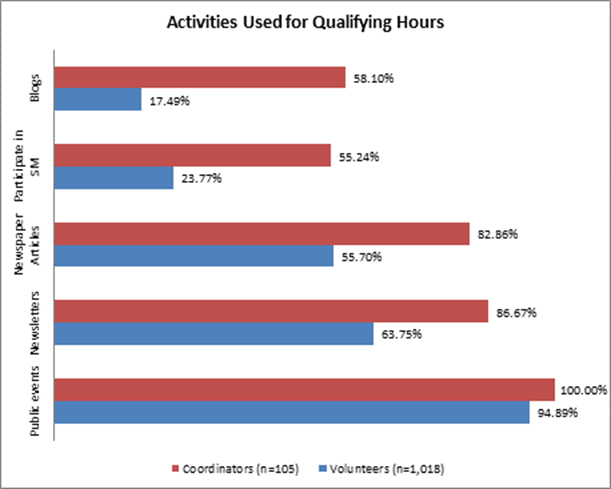
When coordinators were asked to respond regarding perceived barriers to participation of volunteers in an online training program, their responses indicated greater limitations than those indicated by the volunteers themselves (Figure 7). The greatest limitation to participation for volunteers is time. Coordinators appeared to be less confident in the volunteers' technology skills than were the volunteers themselves. In addition, coordinators suggested a much greater lack of volunteer interest in the online training and general limitations for volunteer participation.
Figure 7.
Differences in Responses by Coordinators on Behalf of Volunteers and Responses by Volunteers Related to Limitations to Participation
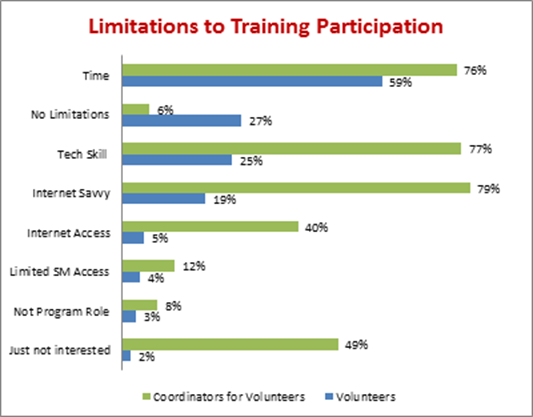
Conclusions
Conclusions drawn on the basis of the study findings can be organized into the categories of program needs and program support.
Program Needs
The responses to the survey indicate that sufficient interest exists to support development of a nationally coordinated social media training for EMG volunteers. The primary objective for the training should center on how to guide discussions around research-based educational topics related to program objectives in a social media environment. On the basis of the findings, development of such a training is under way.
Coordinators were included in this survey because of the leadership role they play in oversight of volunteer training and activities and, in general, in determining program direction. As a result of their feedback, training also is being provided to meet their needs in working with volunteers in this area. One way in which coordinators can provide support is by encouraging local or state governments to allow the use of social media for program delivery and interaction with clientele. This idea is supported by the findings of Newbury et al. (2014) regarding needs for training and development of talking points relevant to counties' not understanding the value of social media.
In regard to program credentialing, a decision needs to be made at the local or state level to account for the variability in programs across the country.
Program Support
More than half of the coordinators who responded support use of social media in the EMG program. However, only about a quarter of the volunteers were aware of this support. This finding suggests the need to increase the acceptance of social media as a qualifying activity in EMG programs nationwide. In addition, coordinators should communicate their support in this area. This communication might be done by assisting in the marketing of the nationally coordinated training. Another positive contribution would be to include time spent with social media as qualifying volunteer hours. In places where there are challenges associated with social media policies that prohibit this type of engagement, educators may need to take leadership in providing policy makers with a summary of program benefits that result from using these platforms.
In our survey results, we found several discrepancies between the information provided by the volunteers and the information coordinators provided on their behalf. There are several possible reasons why these discrepancies exist. Although the EMG program is a national program, the program may be administered differently in different locations. Because all our volunteers' and coordinators' responses are not from the same states, some of the discrepancies may be due to differences that exist in local implementations of the EMG program. It is also possible that the coordinators, in their coordinator role, may have more internal knowledge regarding program direction and that this knowledge may be influencing their views of what they feel the volunteers should need. If this is the case, there may be a need to involve volunteers in setting program direction and focus.
Because the survey did not use probability sampling, the results are not generalizable to the total population of EMGs. The survey probably appealed most strongly to volunteers who had computers and were more comfortable using computer technology in general. This situation may account for some of the variability between the responses of volunteers and the responses of coordinators. Even the volunteers noted that other volunteers may be less likely to share their interest in online program interaction. Although there were large numbers of both volunteer respondents and coordinator respondents, only 22 states were represented in the responses received. Multiple opportunities were provided to encourage participation, but it would have been helpful to have had a process for following up with and encouraging response from the missing states specifically. Therefore, caution should be used in interpreting the findings of the study.
Finally, the study was intended primarily to determine whether there was sufficient interest for developing the training program. As such, the method employed provides the desired information; however, it does not permit generalization to the national EMG population (Dillman, Smyth, & Christian, 2009). The survey could be viewed as an effective prestudy for further research into the needs of coordinators and volunteers in the EMG program.
References
Cooperative State Research, Education, and Extension Service (CSREES). (2009). 2009 Extension master gardener survey. Retrieved from http://www.extension.org/mediawiki/files/f/f5/Extension_MG_Survey_4-9.pdf
Dillman, D. A., Smyth, J. D., & Christian, L. M. (2009). Internet, mail, and mixed-mode surveys: The tailored design method (3rd ed.). Hoboken, NJ: John Wiley & Sons, Inc.
Gharis, L. W., Bardon, R., Evans, J. L., Hubbard, W. G., & Taylor, E. (2014). Expanding the reach of Extension through social media. Journal of Extension [online], 52(3) Article 3FEA3. Available at: http://www.joe.org/joe/2014june/a3.php
Langellotto-Rhodaback, G. A. (2010). Enrollment, retention, and activity in an online master gardener course. Journal of Extension [online], 48(4) Article 4RIB3. Available at: http://www.joe.org/joe/2010august/rb3.php
McAleer, P. (2005). A national survey of master gardener volunteer programs. Retrieved from www.nifa.usda.gov/nea/plants/pdfs/survey_master_gardner_programs.pdf
Meyer, M. H., Haynes, C., Ellsworth, D., Williams, S. E., Welty, C., & Jeannette, K. (2012). An online plant diagnostics module for Extension master gardeners. HortTechnology, 589–591.
Newbury, E., Humphreys, L., & Fuess, L. (2014). Over the hurdles: Barriers to social media use in Extension offices. Journal of Extension, [online], 52(5) Article 5FEA1. Available at: http://www.joe.org/joe/2014october/a1.php
Perrin, A., & Duggan, M. (2015). Americans' Internet access: 2000–2015. Retrieved from http://www.pewinternet.org/2015/06/26/americans-internet-access-2000-2015/
Pew Research Center. (2014a). Broadband vs. dial-up adoption over time. Retrieved from http://www.pewinternet.org/data-trend/internet-use/connection-type/
Pew Research Center. (2014b). Internet use over time. Retrieved from http://www.pewinternet.org/data-trend/internet-use/internet-use-over-time/
Schrock, D. S., Meyer, M., Ascher, P., & Snyder, M. (2000). Reasons for becoming involved as a master gardener. HortTechnology, 626–630. Retrieved from http://horttech.ashspublications.org/content/10/3/626.full.pdf+html?sid=1d817ecd-d323-46cf-925b-ddebfe35b6e3
VanDerZanden, A. M., & Rost, B. (2003). Internet video access appears difficult for Oregon Extension master gardeners. HortTechnology, 385–387.
Young, L. (2007). Re-designing a master gardener training program to meet the changing needs of volunteers and Cooperative Extension. Journal of Extension [online], 45(5) Article 5IAW2. Available at: http://www.joe.org/joe/2007october/iw2.php




